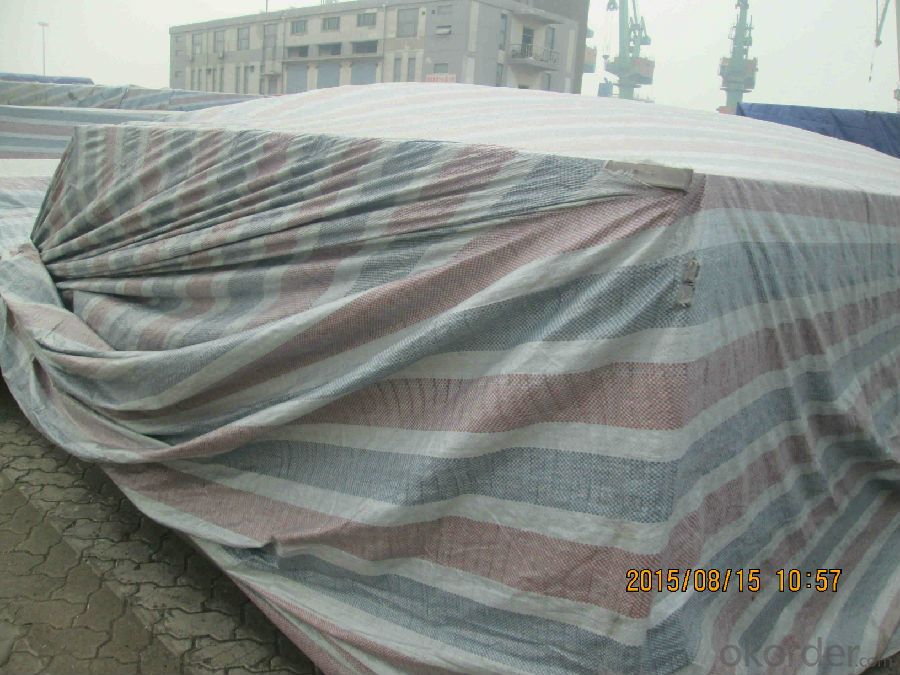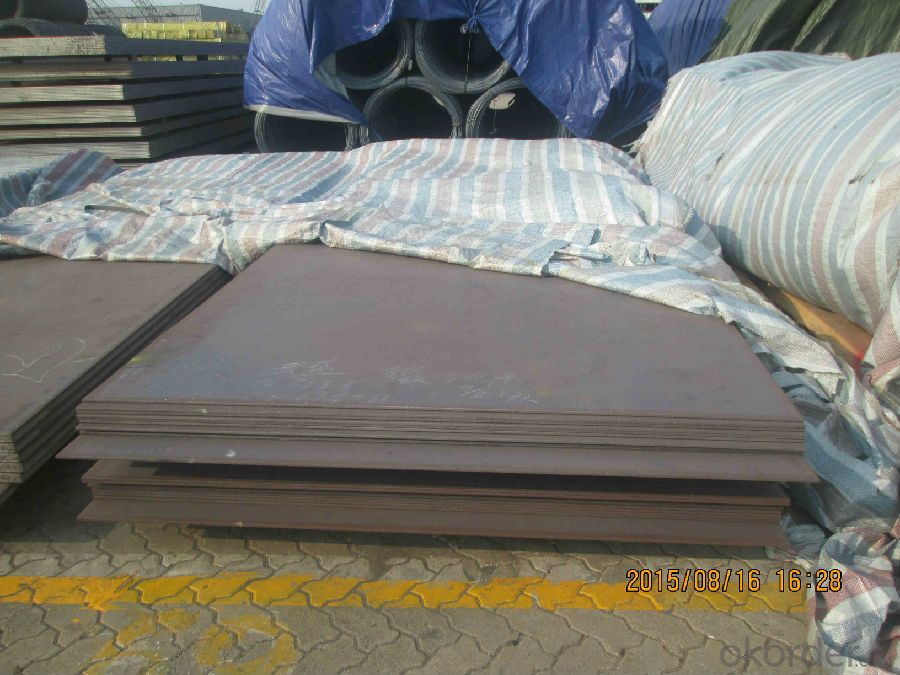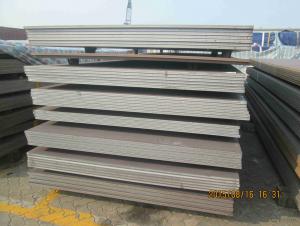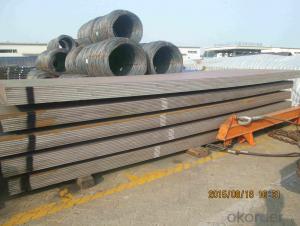Hot Rolled Carbon Steel Plates in High Quality
- Loading Port:
- China main port
- Payment Terms:
- TT OR LC
- Min Order Qty:
- 500 m.t.
- Supply Capability:
- 20000 m.t./month
OKorder Service Pledge
OKorder Financial Service
You Might Also Like
Product Description:
OKorder is offering Hot Rolled Carbon Steel Plates in High Quality at great prices with worldwide shipping. Our supplier is a world-class manufacturer of steel, with our products utilized the world over. OKorder annually supplies products to African, South American and Asian markets. We provide quotations within 24 hours of receiving an inquiry and guarantee competitive prices.
Product Applications:
Hot Rolled Carbon Steel Plates in High Quality are ideal for structural applications and are widely used in construction,machinery manufacturing, container manufacturing, shipbuilding, bridge construction. Can also be used to manufacture a variety of containers, the furnace shell, furnace plate, bridge and vehicle static steel plate, low alloy steel plate,shipbuilding plate, boiler plate, pressure vessel plate, pattern plate, tractor parts, automobile frame steel plate and welding components.
Product Advantages:
OKorder's Hot Rolled Carbon Steel Plates in High Quality are durable, strong, and wide variety of sizes.
Main Product Features:
· Premium quality
· Prompt delivery & seaworthy packing (30 days after receiving deposit)
· Corrosion resistance
· Can be recycled and reused
· Mill test certification
· Professional Service
· Competitive pricing
Product Specifications:
Standard:AISI, ASTM, DIN, GB, JIS
Grade:Q195,Q235,SS400,A36,Q345B
Thickness:1.5mm-200mm
Place of Origin:Tianjin, China (Mainland)
Model Number:1.5mm-200mm steel plate
Type:Steel Plate
Technique:Hot Rolled
Application:Ship Plate
Special Use:High-strength Steel Plate
Width:600mm-3200mm
Length:any length
MOQ:500 tons
Steel Plate
1.Dimension:8-100
2.Length:1000-12000
3.Grade:Q235,SS400,A36,Q345
4.Large stock, low price, high quality
FAQ:
Q1: Why buy Materials & Equipment from OKorder.com?
A1: All products offered byOKorder.com are carefully selected from China's most reliable manufacturing enterprises. Through its ISO certifications, OKorder.com adheres to the highest standards and a commitment to supply chain safety and customer satisfaction.
Q2: How do we guarantee the quality of our products?
A2: We have established an advanced quality management system which conducts strict quality tests at every step, from raw materials to the final product. At the same time, we provide extensive follow-up service assurances as required.
Q3: How soon can we receive the product after purchase?
A3: Within three days of placing an order, we will arrange production. The normal sizes with the normal grade can be produced within one month. The specific shipping date is dependent upon international and government factors, the delivery to international main port about 45-60days.
Images:


- Q:What are the limitations of using steel sheets?
- There are several limitations associated with using steel sheets in various applications. Firstly, steel sheets are relatively heavy compared to other materials, which can pose challenges in terms of transportation and installation. This weight can also limit their use in applications where weight reduction is critical, such as aerospace or automotive industries. Secondly, steel sheets are susceptible to corrosion, especially when exposed to moisture and chemicals. If not properly protected, this can lead to rusting and a decrease in structural integrity over time. Therefore, additional coatings or treatments are often required to prevent corrosion, adding to the overall cost and maintenance requirements of steel sheet usage. Another limitation is that steel sheets have limited flexibility and cannot be easily molded or shaped into complex forms. This restricts their use in applications where intricate designs or curved surfaces are required, such as in the construction of curved roofs or architectural structures. Furthermore, steel sheets have poor thermal insulation properties, meaning they conduct heat and cold more readily than other materials. This can result in temperature fluctuations and energy loss in buildings, requiring additional insulation measures to maintain thermal comfort and energy efficiency. Lastly, steel sheets are a finite resource and their production can have a significant environmental impact. The extraction of raw materials, energy consumption, and carbon emissions associated with steel production make it less sustainable compared to alternative materials. In summary, while steel sheets are widely used for their strength and durability, their limitations include their weight, susceptibility to corrosion, limited flexibility, poor thermal insulation properties, and environmental impact. These limitations should be considered when selecting materials for specific applications.
- Q:What is the average lead time for ordering steel sheets?
- The average lead time for ordering steel sheets can vary depending on various factors such as the supplier, quantity required, customization needs, and current market conditions. However, on average, the lead time for ordering steel sheets typically ranges from a few days to several weeks. If the steel sheets are readily available in stock with the supplier, the lead time could be as short as a few days or even less, allowing for quick fulfillment of the order. However, if the steel sheets need to be sourced from a specific mill or manufacturer, the lead time can be longer. This is especially true if the order requires custom specifications, such as specific dimensions, finishes, or grades of steel. Other factors that can affect lead time include the supplier's production capacity and workload, transportation and logistics considerations, and any potential delays caused by unforeseen circumstances such as natural disasters or labor disputes. It is crucial to communicate with the supplier or manufacturer to get accurate lead time estimates for ordering steel sheets. They will be able to provide specific information based on their production capabilities and current circumstances. Additionally, it is always advisable to plan ahead and allow for some buffer time to account for any potential delays or unforeseen challenges that may arise during the ordering process.
- Q:Are steel sheets available in different textures?
- Yes, steel sheets are available in different textures.
- Q:How do steel sheets compare to glass sheets?
- Steel sheets and glass sheets have distinct properties that make them suitable for different applications. Steel sheets are known for their strength, durability, and resistance to corrosion, making them ideal for construction, automotive, and industrial purposes. On the other hand, glass sheets are transparent, allowing light to pass through, making them well-suited for windows, mirrors, and decorative elements. While steel sheets provide security and structural integrity, glass sheets offer aesthetics and visual appeal. Ultimately, the choice between steel and glass sheets depends on the specific requirements and intended use of the material.
- Q:Are the steel sheets corrosion-resistant?
- Yes, steel sheets can be corrosion-resistant depending on the type of steel used and the protective coating applied. Stainless steel sheets, for example, are known for their excellent corrosion resistance due to the presence of chromium that forms a passive protective layer on the surface. Additionally, galvanized steel sheets are coated with a layer of zinc, which acts as a sacrificial barrier to protect the underlying steel from corrosion. Other types of steel sheets can also be made corrosion-resistant through the application of coatings or treatments such as painting, powder coating, or plating. Therefore, it is important to consider the specific type of steel and any additional protective measures taken to determine the corrosion resistance of steel sheets.
- Q:What is the difference between a black and pickled steel sheet?
- The main difference between a black steel sheet and a pickled steel sheet lies in the surface finish and the process they undergo. A black steel sheet, also known as hot-rolled steel, is produced through a process called hot rolling. During this process, the steel is heated above its recrystallization temperature and passed through rollers to achieve the desired thickness. The resulting sheet has a dark, rough, and scaly surface, hence the term "black steel." The black surface is a result of the oxidation that occurs during the hot rolling process. On the other hand, a pickled steel sheet is produced through a process called pickling. After hot rolling, the black steel sheet undergoes a treatment where it is immersed in an acidic solution, typically hydrochloric acid or sulfuric acid. This pickling process removes the oxide scale from the surface of the black steel sheet, resulting in a smooth and clean surface. The pickling process also helps to improve the steel's corrosion resistance. The choice between a black steel sheet and a pickled steel sheet depends on the intended application. Black steel sheets are often preferred for structural components, such as beams and columns, where surface appearance is not a critical factor. Pickled steel sheets, with their smooth and clean surface, are commonly used in applications where a high-quality finish is required, such as automotive panels, appliances, and architectural elements. In summary, the key difference between a black steel sheet and a pickled steel sheet is the surface finish. The black steel sheet has a rough and scaly surface due to oxidation during hot rolling, while the pickled steel sheet has a smooth and clean surface after undergoing a pickling process to remove the oxide scale.
- Q:Can steel sheets be used for manufacturing shipping pallets?
- Certainly, the utilization of steel sheets is applicable in the production of shipping pallets. Steel, a material known for its strength and durability, is capable of enduring heavy loads, rendering it suitable for pallet construction. To establish a robust and dependable pallet structure, steel sheets can be united through welding or bolting. Furthermore, steel pallets possess the added advantage of being resistant to moisture, pests, and fire, which holds significance in certain industries or applications. Nevertheless, it is important to acknowledge that steel pallets generally incur higher costs compared to alternative materials like wood or plastic. Therefore, the decision to employ steel sheets for manufacturing shipping pallets would rely on specific requirements, budgetary constraints, and intended utilization.
- Q:Are steel sheets suitable for earthquake-prone regions?
- Yes, steel sheets are suitable for earthquake-prone regions. Steel has high strength and ductility, which enables it to withstand the lateral forces and ground shaking caused by earthquakes. It is a flexible material that can absorb and dissipate seismic energy, reducing the risk of structural damage. Additionally, steel structures can be designed to be lightweight yet resilient, making them an ideal choice for earthquake-resistant construction.
- Q:How do steel sheets compare to aluminum sheets in terms of strength?
- Steel sheets are generally stronger than aluminum sheets. Steel is known for its high tensile strength, which means it can withstand greater forces before deforming or breaking. On the other hand, aluminum sheets have lower tensile strength and are more prone to bending or warping under heavy loads. However, it is important to note that aluminum sheets can still be strong enough for many applications, especially when considering their lower density compared to steel. Additionally, aluminum sheets have the advantage of being more lightweight, corrosion-resistant, and having better thermal conductivity than steel sheets. Therefore, the choice between steel and aluminum sheets depends on the specific requirements of the project, considering factors such as strength, weight, corrosion resistance, and thermal properties.
- Q:How many times a day can a steel pile be inserted?
- 12m Larson steel sheet pile 450 machine, about 80 a day, according to the geological conditions and construction conditions and other factors, there are differences.
1. Manufacturer Overview |
|
|---|---|
| Location | |
| Year Established | |
| Annual Output Value | |
| Main Markets | |
| Company Certifications | |
2. Manufacturer Certificates |
|
|---|---|
| a) Certification Name | |
| Range | |
| Reference | |
| Validity Period | |
3. Manufacturer Capability |
|
|---|---|
| a)Trade Capacity | |
| Nearest Port | |
| Export Percentage | |
| No.of Employees in Trade Department | |
| Language Spoken: | |
| b)Factory Information | |
| Factory Size: | |
| No. of Production Lines | |
| Contract Manufacturing | |
| Product Price Range | |
Send your message to us
Hot Rolled Carbon Steel Plates in High Quality
- Loading Port:
- China main port
- Payment Terms:
- TT OR LC
- Min Order Qty:
- 500 m.t.
- Supply Capability:
- 20000 m.t./month
OKorder Service Pledge
OKorder Financial Service
Similar products
New products
Hot products
Related keywords






























